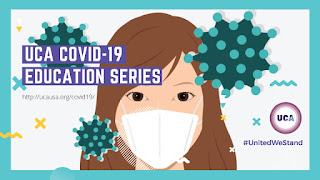16: Food Disinfection
Q: How should I disinfect food or grocery?
💁Tracy: Food in supermarkets may get infected with droplets or via touching by people carrying the virus. But don’t panic, you can enjoy the food as long as the food is disinfected.
Please pay attention to and follow the recommendations below:
Disinfection of fresh vegetables and fruits:
For kitchen disinfection, please see “Kitchen Disinfection”
[2] https://youtu.be/sjDuwc9KBps
💁Tracy: Food in supermarkets may get infected with droplets or via touching by people carrying the virus. But don’t panic, you can enjoy the food as long as the food is disinfected.
Please pay attention to and follow the recommendations below:
- Wash your hands thoroughly before and after preparing food.
- Please do not use the same knives and chopping boards for cooked and raw food, especially for raw meat and fish. Knives and cutting boards need to be washed after each use and disinfected with bleach frequently.
- Cook and/or heat food thoroughly. Do not eat raw meat, eggs, and milk, for example, sashimi, half-cooked steak, etc. If you are not sure about milk, boil the milk before consuming it.
- Wear gloves if needed to handle food packaging and containers coming back from supermarkets, including paper bags, plastic bags, plastic food wrappers, and fast-food boxes. Disinfect food containers before opening them.
- Heat take-out food before eating. For details, please see “Disinfection of Takeout and Deliveries”.
- Do not use disposable silverware from restaurants. If you do, please disinfect with alcohol before use.
Disinfection of fresh vegetables and fruits:
- For vegetables and fruits that can stay outside fresh, don’t put them into refrigerators without disinfecting them. Instead, keep them separately in cool places such as garage or storage for 3 days and above as a way to deactivate the virus.
- Fruits and vegetables that can be washed easily, use dish soap and hot water to clean them then dry out, before putting into the refrigerator. You can also wipe the surfaces of fruits, such as apple or pear, with 70%-75% alcohol then rinse with water. Another way is to put them in boiling water for a few minutes. Peel the skins before eating if needed.
- For salad, berries, such as strawberries, raspberries, berries, blackberries, etc, that are not easy to disinfect thoroughly, it is better to avoid them. Otherwise, you can either soak them first in hydrogen peroxide then rinse thoroughly with clean water. Alternatively, steam them or put them in boiling water for a few minutes to disinfect.
- If vegetables and fruits were stored in the freezer before the pandemic, they are safe to consume as long as they are not expired or contaminated.
- If you are not sure about the item, either delivered or bought from stores, always clean, cook, heat up (> 133F for more than 30 mins, put into boiling water or steamer for a few minutes) before eating.
For kitchen disinfection, please see “Kitchen Disinfection”
Tracy’s Toolbox
ü 70%-75% alcohol
ü Dish Soap
ü Disinfectants labeled as "bleach"; Bleach (hydrogen peroxide or chlorine disinfectant) or disinfectants labeled as "bleach".
|
Reference
[1] Hyde J L, Blackwell J H, Callis J J. Effect of pasteurization and evaporation on foot-and-mouth disease virus in whole milk from infected cows[J]. Canadian Journal of Comparative Medicine, 1975, 39(3): 305.[2] https://youtu.be/sjDuwc9KBps
Writing: Vicki Cheng, Jingyi Xi; Translation: Chaoyu Xie; Proofreading: Alice Cai; Artwork: Henry Yuanheng Hu
Disclaimer and Copyright © 2020 United Chinese Americans










